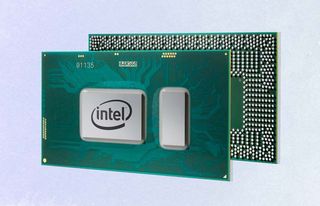Intel's 8th Gen Core Branding Will Confuse the Masses
Almost one year ago, we called bullchip on Intel’s naming convention for its seventh generation, “Kaby Lake” CPUs. Little did I know that with the eighth generation, it would get even worse.

With the seventh generation, Intel mostly removed Core m CPUs, re-branding them as Core i and calling them Y-series, a part the computer illiterate know nothing of. But what Intel’s doing now is so confusing that even if you know everything there is to know about your computer, you still may not know exactly what you’re getting.
See, Intel’s 8th generation CPUs aren’t all based on the Coffee Lake architecture, like we expected. Instead, Intel told us, it will include a refreshed version of Kaby Lake (14nm+) at launch, followed eventually by Coffee Lake (14nm++) and at some point by the long-awaited Canon Lake (10nm).
That means the 8th generation of Intel’s CPUs will not only go across many lettered CPU series (which at this point is normal), but you might not even know which of three architectures you’re getting.
“Think about the people that are buying these laptops,” an Intel spokesperson told me. “These are for the mainstream consumer. So when they are heading into a [store] to purchase a laptop, they are looking for the latest and greatest. Last year, you know we made that change to add the generation number to the badges. Intent was to help people looking for the newest and best processors at that given time. This continues with 8th Gen. So, when a mainstream consumer goes to buy their laptop, they see 8th Gen and know they are getting the newest and best at that moment.”
To the average person, which chip architecture you get probably doesn’t matter. But Coffee Lake and Cannon Lake are likely to have different bumps in performance, changes in battery efficiency and heat. They’ll both have those 8th Gen badges. Between that and several lines of each chip, is it really fair to say you’re getting the same thing? Unlike Y and U series chips, we can’t test this yet, but I’m almost afraid to find out how it changes among several chips under the same umbrella.
You might not even know which of three architectures you’re getting.
On top of that, one of Intel’s generations tends to last a year, and few laptop makers refresh a product more than once a year. So when you go to grab your next machine, if it refreshed earlier in the cycle, you may not actually be getting the latest.
Stay in the know with Laptop Mag
Get our in-depth reviews, helpful tips, great deals, and the biggest news stories delivered to your inbox.
What we don’t know yet, and Intel isn’t ready to tell, is how this split will affect different product lines. Right now, we’ve only learned about the Core i5 and Core i7 U-series CPUs, a new line of quad-core chips for notebooks. That means we’re still waiting on information for a bunch of chips for enthusiast and workstation laptops, as well as desktops. Will Coffee Lake or Canon Lake be specific to one type of device? Only for certain series? We don’t yet know that, either, but it’s all the same name.
MORE: Intel 8th Gen Core CPUs: What You Need to Know
It’s possible that the SKU numbers will clarify this to a degree, but how many people do you know that can parse a CPU model number? Many stores and even some manufacturers don’t list anything beyond Core i3, Core i5 or Core i7.
Everyone deserves to know what they’re buying, whether it’s technology or anything else
It doesn’t seem that Intel will be cleaning anything up anytime soon, either. The company has already announced its Ice Lake architecture, which will be made as a refinement to Canon Lake. It’s likely to be part of the ninth generation of Intel CPUs.
Add this to the odd mix up between U series and Y series (at least the rest of the number soup is almost exclusively for enthusiasts), and we get further into a world where someone goes to a store, sees Core i-whatever, and doesn’t truly know what they’re getting.
PC-building folks will figure it out. People like me who write about this for a living will get it. But ultimately, everyone deserves to know what they’re buying, whether it’s technology or anything else, and including all of these different architectures.
Computers enable people to create, play games, connect with friends and family and mindlessly browse the web. Intel powers the majority of the laptop market, and I think it’s the company’s duty to make it easy to buy and know what you’re getting. I really hope it finds a way to clear this mess up, but its chip lineup only seems to be getting more confusing to anyone out of the know.
Windows 10 Basics
- 7 Settings to Change Right Away
- Windows 10 Keyboard Shortcuts to Save You Clicks
- 5 Ways to Take Screenshots
- Change Your Password in Windows 10
- Uninstall Programs in Windows 10
- Enable or Disable Tablet Mode
- Add a User (Child or Adult)
- Change the Screen Resolution
- Sync Your Settings Across Devices
- Sync iPhone with Windows 10
- Control Windows 10 with Your Voice
- Upgrade to Windows 10 From Windows 7 or 8
- Eliminate Blue Light With Night Light
- Create a New Folder
- Get to the Desktop in Windows 10
- Add a Printer
- All Windows 10 Tips
- Set Alarms
